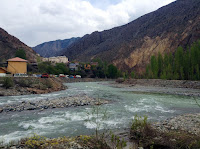Environmental battles along Turkey's Black Sea coast
 |
| The mountain town of Yusufeli, slated to be flooded by the reservoir of a dam |
The Black Sea region’s lush forests and small mountain villages provide a striking backdrop for the fierce battle being waged there, a fight pitting farmers, fishermen, and beekeepers against the powerful government and corporate interests seemingly intent on bulldozing the landscape and damming its life-giving waterways in the name of “progress” and profit.
“We were born hearing the voice of this river and we will die with it” is a commonly expressed sentiment among Black Sea villagers, whose honey harvests, hazelnut crops, and vegetable gardens all depend upon the region’s rivers. Though the threat of dams looms the largest, gold mining and other extractive industries also put people’s health, homes, and livelihoods at risk.
 |
| A copper mine and its tailings ponds loom above the town of Murgul |
With a grant from Mongabay's Special Reporting Initiatives, I traveled this spring across the eastern Black Sea, from the port city of Trabzon to the mountain towns of Artvin, Murgul, and Yusufeli, taking in the gorgeous -- but in many cases already blighted -- scenery and talking to local residents and activists about the threats they and their homes face.
Read my first two articles from this reporting trip on the Mongabay website: